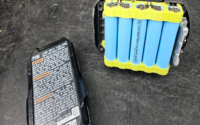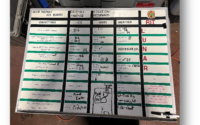Chemical Suicide
Todd Burton
Recently I was told there was a Detergent Suicide on the East Coast. It has been a while since we have been responding to these calls. Good chance there has been a lot of turnover on your Hazmat Team and it’s a good opportunity to review the types of chemical suicide and take a closer look at the method called “Detergent Suicide.” When I worked for San Diego County Hazmat, we did a Detergent Suicide study and learned a lot and I want to share some of that information with you. There is also a video on YouTube showing the reactions in a vehicle with plumbed monitors and real time readings. You may know a lot of this, but you just might pick up a nugget or two that can make your response smoother.
There has been a lot written about Chemical Suicides over the years. There is plenty of guidance on the internet for first responders now a days. The methods for Chemical Suicide have not changed too much over the years. There are quite a few methods, and we could do an article on each one of these, but I am sure it’s already been done. We all know the list, except the newbies on the teams.
- Inert Gas. Most of the time Hazmat Teams don’t even get called out to the inert gas suicides as it is a straightforward response. Maybe a phone consultation with the crew. Conduct a little air monitoring for oxygen displacement. Usually using Helium or Nitrogen. Sometimes it’s propane, that’s a bit different.
- Carbon Monoxide, the BBQ in the bathroom or generators. Like inert gas but it may require a little more expertise from the hazmat team to monitor adjacent units in all directions to ensure its safe for the neighbors to return to their homes. Also, will need to ensure it’s safe for investigators to come in and do their job once it’s all ventilated. Remember CO is a flammable gas in high concentrations.
- Carbon Monoxide via Formic Acid and Sulfuric acid. Not very common. Mixing these generates a lot of CO gas, not generally flammable but you have acids to deal with to stop the reaction via dilution and neutralization. Remember sulfuric can get really hot with water so overpower it in a larger container with correct PPE.
- A newer method is ingesting Sodium Nitrite with anti-vomiting agents. No off gassing from the victim that I am aware of. These are the suicide kits that have been purchased off Amazon.
- Detergent Suicides. Hydrogen Sulfide generation from mixing acids and pesticides. Key here is the yellow liquids in a bucket. We will focus on this one and talk about some of the nuances of this method. Also, a flammable gas at high concentrations.
- Drinking pesticides, usually Malathion. This one is messy. Usually vomit all over the place. Be prepared for this if you transport the victim, you will need PPE! Need a negative pressure room at the ER or outside area to treat them as they will keep vomiting and this may cause an evacuation of the ER.
- Ingesting Cyanide Salts
This one is rare and usually occurs with students or professors. You will pick up <10 ppm Hydrogen Cyanide gas around the mouth. If the medics try to revive the victim, they may expel more Hydrogen Cyanide gas out the mouth. Upon autopsy the levels will be greater than the IDLH. Help your Medical Examiner as they usually only have Air Purifying Respirators (APRs or Powered APRs) for respiratory protection. And the Hazmat Team can provide monitoring during autopsy to keep the doctors safe.
- Ingesting Aluminum or Zinc Phosphides. Not common but very toxic when ingested. Makes Phosphine Gas. Flammable gas LEL 1.79% but the ingestion of this will only produce gas in the ppm range. In the stomach it reacts with hydrochloric acid and water to make Phosphine. Phosphine will continue to come out of the mouth area at concentrations that will cause symptoms for those not wearing respiratory protection. Keep these patients outside the ER in a tent or in a negative pressure room that can be monitored with phosphine sensors from the hazmat team.
- Ingesting Sodium Azide. Also, very toxic and can twist the call based on Tech Ref research as it’s used in airbags and is listed as an explosive. Not normally a problem in a lab bottle. It requires electrical stimulus to set it off. The off gassing from the mouth can be Hydrazoic acid. Acetic Acid Drager’s can pick this up allegedly. Could also use an FID like the AP4C to look for Nitrogen.
When you stop to think about it there are probably more methods, I have not listed above but these are the most common ones we run into. You will probably also see overdoses with narcotics, like Fentanyl.
Let’s talk about Detergent Suicide as I was told this occurred in New York state a couple of weeks ago. This is the famous method that was going strong around 2013. They put up signs in the car stating it’s a toxic gas and you can die with one breath and not to enter the vehicle. Sometimes this is done in a small room in a house or apartment complex. The gas has a very low odor threshold in the parts per billion. You will smell it before your 4-gas picks it up. That’s a clue for good monitoring and respiratory protection at that point. Keep an eye on that meter! When I worked for San Diego County Hazmat, we took some time to take a close look at this method as it was new, dangerous and we needed to come up with some answers.
Most responders know that acid and pesticide are used to make this gas. The acid source is normally Muriatic acid, and the pesticide is a sulfur-based fungicide or sulfur product. When mixed the product that is produced is Hydrogen Sulfide gas, in copious amounts! Hydrogen Sulfide is the stinky rotten egg odor we associate with organic decomposition in sewers/storm drains or confined spaces. This gas will kill a person around 800-1000 ppm. Our 4-gas can read Hydrogen Sulfide but normally only up to the IDLH, which is 100 ppm. It can also knock out your sense of smell around this level. Lets look at some key items for response on this method.
TOXICITY
Very toxic via inhalation. Not a skin issue. You can decon via fan. Peel off your turnouts after fan decon, put in a plastic drum liner and let them sit for a while. Then poke a small hole in the bag and push on the bag to expel the air and see if you get readings on your 4-gas H2S sensor, if you do they need a better airing out. Should be reading very low depending on how clean your turnouts are.
REACTION RATE
FAST! This reaction is immediate and can fill a normal sedan with 15,000 ppm of toxic Hydrogen Sulfide gas in 3-4 min. This is a body recovery. Gas can remain at lethal levels for 30-60 minutes inside a small space (See YouTube video).
PPE
Wear turnouts/BA as it is a flammable gas at high concentrations and not a skin issue. Acid is a skin issue and for that mitigation we need Level B PPE.
Chemical and Physical Properties
| Smel it in the 0.5 PPB range | OSHA PEL C 20 ppm | IDLH 100 ppm |
| Kills you 800-1000 ppm | ||
| Flammable Range: 4-44% (LEL is 40,000 ppm) | IP 10.46 | It’s a heavier than air gas 17 ATM Relative Gas Density 1.19 |
| Solubility is low 0.4% | Colorless gas | Rotten egg odor |
As for the flammability issue, LEL 40,000 ppm or 4%. We did address this issue in a study with different volumes of reactants, and we could not get the Hydrogen Sulfide gas to exceed 38% LEL (15,200 ppm H2S Gas) even with large volumes of reactants (1 gal of each reactant).
INSTRUMENTATION
4-Gas (H2S sensor tops out normally at 100 ppm). You will also pick up air borne acid gases with PH paper that may affect your 4-gas. It may be worth while to test for this first in cracks and crevices of small spaces as you start to use your 4-gas (See PH paper in the attached document)
PID can ionize the gas, if using RAE/Honeywell PID the TN-107 CF for a 10.6 lamp is 3.3. Example: if you are monitoring with your 4-gas and it is over range you may want to use your PID and if is reading 300 ppm. Multiply that by 3.3 = 990 ppm, you are in the lethal range. One note on extended use of a PID in monitoring this gas is that it will coat the lamp, and your readings will start to be lower than initial readings giving you a false sense of security that the readings are lower when the PID is just not able to ionize the gas due to the coating of the bulb. Just my experience during our study. Most normal use should be fine.
HOW FAR DOES THE GAS TRAVEL
Well, that’s going to depend on your environmental conditions. In the study we used an open space that did have a slight breeze. H2S gas readings around the car were greater than >100-300 ppm at 25’ (See attached document). In the study we used 1gal of each reactant and opened the doors to a lethal level and it vented to 0 ppm in 15 minutes. At 75’ away, downwind our monitor was reading less than 10 ppm.
This is a true knock down gas. There were reports of law enforcement in Florida being knocked down by the gas at close range. I believe in Canada also when they removed the bucket from the vehicle.
DECONTAMINATION
Fresh air. Use fans, air out turnouts. Use the bag procedure mentioned above to check turnouts for contamination. If contaminated with acids that’s a different story. Follow your agency’s procedure but they will need to be neutralized. And checked with PH paper and assessed if they can still be used. In the study we used an inflatable dummy in each trial. Bagged the dummy in a body bag and tested for H2S the following day. They did have a rotten egg odor but were not above any H2S PEL.
WHAT DO YOU DO WITH THE MIXTURE IN THE BUCKET?
The reactants need to be neutralized to stop generating the H2S gas. This should be done in Level B. Even moving the bucket in street clothing can generate lethal levels of gas due to reactants recirculating in the bucket coming in contact with each other producing H2S gas again. If the mixture is neutralized with soda ash, it is still considered hazardous waste by California standards as it fails the fish kill test. Therefore, it needs to be disposed of as a hazardous waste. If you use fast set concrete, it neutralizes the mix, solidifies it and it passes the hazardous waste test. It does not produce further H2S gas when more acid is added. But follow your local regulations for disposing of said mixtures.
By doing the study and having responded to many Detergent Suicides, we have come up with a Standard Operating Guidance (SOG) for this type of response.
Action Plan Considerations:
Isolate the area out to 150’
1) Set up perimeters and zones
2) Deny entry to unauthorized personnel
3) Eliminate any ignition sources
Begin Site Safety / Incident Action Plan.
1) Interview any witnesses or first responders as to the following
i) Any posted warning signs
ii) Buckets/containers with liquids? Powders? What color?
iii) Names on the chemical containers
iv) Any exposed wires at or near door handles or obvious secondary devices
PPE: 1. SCBA & turnouts for recon.
2. Level B for any acid neutralization actions.
Monitoring: Look for secondary devices prior to opening any door (Wires, packages, ect)
1. CGI with H2S sensor.
2. PID, IP is 10.46 and will be ionized by a 10.6 lamp. Correction factor is 3.3 for RAE/Honeywell
3. TIC for chemicals reacting
4. pH paper for acid fumes
Monitoring strategy
- Monitor lower openings in the small space used for H2S gas. Do this around the perimeter of space. If high readings are detected prepare for ventilation operations.
- No H2S detected, continue to assess for secondary devices and start to open rear doors to assess the inside areas. If no gas was detected it may have naturally vented out. If gas is detected prepare for ventilation operations.
Mitigation/Ventilation
- Approach from upwind (DO NOT MOVE THE BODY!)
- The vehicle will need to be ventilated for 15 min. to remove any gas present. This will have to be done in coordination with Law Enforcement to ensure a sufficient perimeter is enforced to prevent exposure to the public. Consider the current weather conditions during the venting process.
- Look again for secondary devices and then open all doors and trunks to ventilate the vehicle.
- Do not remove any signs or evidence from the scene until the medical examiner has allowed you to do so as this is a crime scene.
- Remove the container to a location where it can be neutralized or solidified with concrete in level B.
- Neutralize the acid residue with baking soda, not soda ash as it can clog the Hudson sprayer. Spray all acid residual inside the car/small space to ensure it is neutralized and declared safe. The ph should be between 6-10 ph. Be careful as this process can generate hydrogen sulfide gas by just mixing the residual acid and calcium polysulfide. The acid must be neutralized to stop the chemicals from reacting. Keeping the reaction bucket inside a drum liner will allow capture of any overflows and monitoring of head space for vapors.
- When the acid mixture has been neutralized and the liquids removed and mitigated. The area should be re-monitored to ensure it is safe for the medical examiner staff to enter without PPE.
Medical examiner considerations:
- Decontamination of deceased prior to transport. Verify with ME first.
- Provide copy of Hydrogen Sulfide MSDS to ME
- Hazmat can monitor the head space of the body bag to ensure the gas has dissipated to safe levels for transport and autopsy.
- In past autopsies the interior of the body has not expelled any H2S gas from the lungs.
Contaminated clothing: First Responders
1. Gas contamination – Turnouts/Clothing should be aired out, bagged and monitored for H2S gas.
2. Liquid contamination – Neutralize with base and verify its neutral or dispose of as hazardous waste.
3. Level B PPE should be properly disposed of.

Hopefully you picked up a nugget you can use on your next Detergent Suicide call, hopefully you won’t have one! But with the Holiday’s on the way these kinds of calls seem to have an uptick. Feel free to reach out to me for any questions on the study or other methods not covered in detail above.



